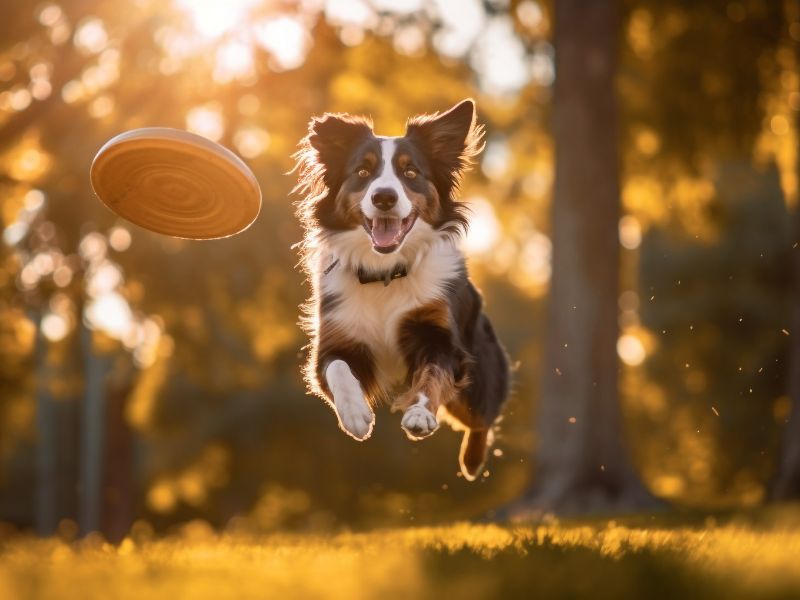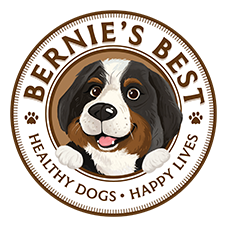Dog Joints and Dog Joint Health: The Canine Motion Enablers
Imagine your dog’s joints are like the hinges on a door; they need to be well-oiled and smoothly functioning for the door to swing open effortlessly. Similarly, your dog’s joints are where two bones meet and need to glide over each other easily. They’re supported by cartilage, squishy stuff that cushions the bones, and synovial fluid, a sort-of natural joint oil that keeps everything moving without a creak. Without this slick system, our pups might feel like they’re moving with a rusted hinge – not fun at all, and not allowing them to live their best life.
Ouch! Joint Problems In Dogs
Now, just like us, dogs can get all sorts of aches and pains in their joints. Osteoarthritis is one of the biggies – it’s when the cartilage gets worn down, and the bones start to get a bit too close together as they attempt to work together, causing pain and stiffness. Then there’s hip and elbow dysplasia, which is like getting a pair of shoes that don’t fit right – it makes walking correctly a bit of a challenge for your dog, so they just eventually do it less and less. There are also patella issues, especially in our smaller breed dog friends – it’s like having a kneecap that decides to go on a walk but keeps sliding out of place and making it hard to keep moving.
Why Do Your Dog’s Joints Suffer?
Several factors can make your dog say, “No thanks” to that game of fetch. Age is a big one – just like us, dogs can’t dodge the aging bullet, and their joints might wear and tear as the birthdays pile up. Breed plays a role too; some breeds have won the genetic lottery for joint issues. Also, if your pup carries a few extra pounds, it’s like adding extra weight to a backpack – it can wear down those joints.
How Much Exercise Should My Dog’s Exercise Routine Have?
The amount of exercise a dog requires can vary based on several factors including age, breed, and health. There’s a consensus among experts that regular physical activity is crucial for maintaining a dog’s health, just as it is for humans. The general guideline is that most dogs should get between thirty minutes and two hours of exercise daily. However, this can differ greatly depending on the dog’s breed and individual needs. For example, high-energy breeds may require more vigorous and extended exercise periods than smaller or less active breeds.
Puppy Joints and Little Breed Concerns
Puppies and small breeds have their own joint stories. Puppies, with all their boundless energy, are still growing. So, their joint care is like taking care of a delicate plant. Too much hard exercise can be tough on their developing bodies. Going for shorter, fun playtimes rather than long, strenuous hikes is better. And those small breeds? They might not have to cover as much ground, but they still need to keep those tiny joints moving to stay spry and healthy. Puppies, with their abundance of energy, require exercise in short bursts, as their bodies are still growing. It’s recommended that their playtime be broken into shorter sessions rather than extended periods of strenuous exercise. A mix of physical activities ranging from walks to more stimulating exercises like running or agility training can be beneficial for adult dogs. As for senior dogs, while they may not have the same stamina as they once did, exercise remains a critical component of their routine, with adjustments made for intensity and type to suit their reduced capabilities.
A Golden Age for Senior Dogs
 For our older furry friends, their joint care is like fine-tuning a classic car. They might not race like they used to, but they can still enjoy a leisurely cruise around the block with the right care. Ingredients that target joint health, like the type-II collagen in Bernie’s Healthy Hips, are great for helping those older joints stay in shape. And when it comes to exercise, think more gentle strolls and less marathon running – it’s all about keeping them moving without overdoing it.
For our older furry friends, their joint care is like fine-tuning a classic car. They might not race like they used to, but they can still enjoy a leisurely cruise around the block with the right care. Ingredients that target joint health, like the type-II collagen in Bernie’s Healthy Hips, are great for helping those older joints stay in shape. And when it comes to exercise, think more gentle strolls and less marathon running – it’s all about keeping them moving without overdoing it.
Balancing Act: Exercise for Every Age
Creating an exercise routine for a dog, whether an energetic pup or a sweet old senior, is all about balance. Puppies need play that matches their energy but doesn’t strain their growing bodies. The adults might enjoy a good run or a game of fetch. And the seniors? They’ll thank you for those gentle walks or a nice swim. It’s like being a personal trainer for your dog, tailoring the workouts to their age and joint health needs. It’s essential to gradually build up to an exercise routine, especially if a dog isn’t used to regular physical activity, and to always watch for signs of fatigue or overheating. Additionally, maintaining a healthy weight through exercise is important as obesity can lead to joint damage and other health problems over time. Before starting any new exercise regimen with your dog, it’s not a bad idea to talk to your vet to ensure that your dog is healthy enough for certain activities and to get a better idea of your dog’s specific exercise needs.
Nutrition: The Secret Ingredients
At Bernie’s Best, we’re science buffs. We pay attention to the research that suggests we need to tailor and evaluate exercise routines for dogs carefully. We know that keeping dogs active doesn’t just keep their joints juiced up, so to speak, but also benefits their (and our) overall health by improving blood flow and muscle strength, among other perks. Bernie and his sister, Lady, are larger breeds and predisposed to joint issues, so we wanted to be sure we were giving them whatever they needed to have the best joint health they could. We also know what your dog eats and takes in from supplements can actually help their joints! Think of food as the secret ingredient for healthy joints. Ingredients rich in antioxidants fight off damage, and omega-3 fatty acids (hello, flaxseed and anchovy oil) are like nature’s anti-inflammatories. Whatever your dog’s age or size, keeping their joints healthy is the best way to ensure they’re able to do all the dog exercise they need without worrying about pain from joint issues. We created Bernie’s Healthy Hips and Bernie’s Marvelous Mobility to be clean, healthy and delicious ways to keep them moving, and we used the most current research and science on what really works. While traditional supplements like glucosamine and chondroitin have been popular in the past, we felt it was important for us to look at what newer, current research suggests for joint health, and not just what’s always been popular. Bernie’s Healthy Hips includes ingredients such as green-lipped mussels, which contain a unique combination of fatty acids not commonly found in other marine organisms. These fatty acids have been shown to help maintain joint cell structure and function. Additionally, astaxanthin, a potent antioxidant found in certain algae and seafood, is known for its ability to help neutralize free radicals in the body, potentially protecting joint tissues from oxidative stress. Vitamin C, as well, plays a role in collagen synthesis (the protein that gives cartilage its strength and structure) and can also act as an antioxidant.
Adapting for Age and Size

Puppies, small breeds, and senior dogs each have specific nutritional needs for their joint health. Puppies, for example, require nutrients that support healthy bone development. Foods and supplements rich in vitamins and minerals, particularly Vitamin K2 and calcium, are crucial for them. Small breeds benefit from a balanced diet that prevents obesity, which can place undue stress on their little frames, of course, and supplements that help maintain those healthy weights are the best. On the other hand, senior dogs may benefit from additional support such as the omega-3 fatty acids and antioxidants to help maintain joint health as they age. We included turmeric/curcumin, renowned for its anti-inflammatory properties, as it can be particularly helpful for aging dogs experiencing stiffness and discomfort. The bottom line is these are all really great for any dog with joint issues, but especially seniors or those who already struggle with hip issues. We know that every time we’re with our best friend, every leap and run is a workout for their joints, no matter what their age. They need to be able to exercise to maintain their joint health, and maintain their joint health so they can exercise. Bernie’s Healthy Hips and Bernie’s Marvelous Mobility can help with both!





